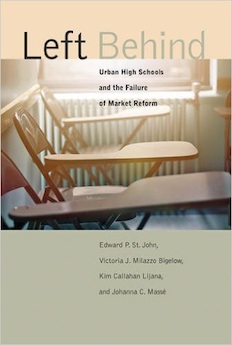By Kayleigh Whitman
Beginning in the 1990s, large amounts of time and money went into researching methods to improve American high school education. What has emerged in the years since is a hybrid of standards driven curriculum and market reform (charter schools). Left Behind: Urban High Schools and the Failure of Market Reform assess how this intersection impacts the experience of the poorest students. Through the unforeseen constraints that are put on public school teachers and administrators by the different programs, Edward P. St. John and his team expose the great irony: those that suffer the most in the current system are the exact students that the policies are intended to help.
Charter schools emerged as the result of the research completed by John Chubb and Terry Moe, who called for market strategies to be utilized in the education system: if students and families can choose where they go to school, then it will compel low performing schools to bring up their performance. Where the model goes awry is with the almost simultaneous emergence of standards driven curriculum. Criteria such as Common Core State Standards (CCSS), which remain highly controversial for many parents and educators, restrict the options of public school teachers. As Left Behind argues, they are ultimately unable to be innovative in the way that keeps pace with charter schools. Since charter schools do not admit all students, there are students who will be left behind in the public schools that are unable to compete for community support at the same caliber as charter schools, are limited in the ways they can model their curriculum to fit the needs of the students, and sometimes struggle to accommodate the national interest in college and career readiness. The authors suggest that this leaves urban low-income students at a disadvantage.
The research team draws its conclusions through their study of four New York City Public Schools and four urban charter schools, citing specific case studies from the different schools and using them as a tool to showcase how students are suffering from the present system. Both the “Math Problems” and “Advanced Literacies” chapters begin by giving an overview of how the different policies play out in regards to the specific subject. In the literacy chapter, for example, the authors explain that the teachers in the charter schools are able to adapt their curriculum to fit the specific needs of their students. One example is the practice of Beta High School, which promotes a “holistic approach” to literacy. Teachers in all subjects incorporate writing into their lessons in order to reinforce what students learn in their English classes. In contrast, public school instructors must stick to their assigned curriculum, meaning that they cannot adapt their lessons to align with other approaches regardless of how beneficial they might be.
Following the more in depth case studies are chapters that present “big picture” critiques of the system. These are particularly useful to readers who may not be as familiar with the history of education policy. These chapters introduce the larger political influences and policy initiatives, explaining how some of these contradictory approaches may have come about and why they have persisted despite evidence that they do not work. These chapters introduce critiques of higher education policy, especially the decline in government investment and its subsequent impact on the US’s place in the global community. This discussion extends the reach of the study, connecting it with the present discussion about higher education reform.
The final chapter of Left Behind brings the reader to perhaps the most concerning part of the study: none of the present policy discussions matter. What is introduced at the beginning of the book, remains persistent throughout, and is driven home at the end is that in both the standards driven schools and the adaptive charter schools graduation rates from college have not improved, test scores have not altered dramatically, and cross generational uplift in these communities has remained constrained. In fact, income inequality has grown since high school reforms began. The final chapter does outline suggestions for the improvement of the system, but the authors note that there are many things beyond education inequality that contribute to the inequality of certain groups. These include global economic conditions and tax policies. In other words, simply adding college preparation to high school curriculum and funneling students into college programs will not fix inequality. Improving educational opportunities is not the ultimate solution, and the authors argue that, in fact, politicians and policy makers are lying to low-income families when they propagate such ideas.
Left Behind does two things: it highlights the problems with the current system while simultaneously calling the reader to ask whether the US as a country is even asking the right questions in its pursuit of a solution to generational inequality.
Kayleigh Whitman (ΦBK, Florida State University, 2014) has a BA in history from Florida State University and a MA from Brandeis University in the same subject. She currently works for Southern Scholarship Foundation, a non-profit in Florida that provides rent-free housing to students with limited financial resources.




